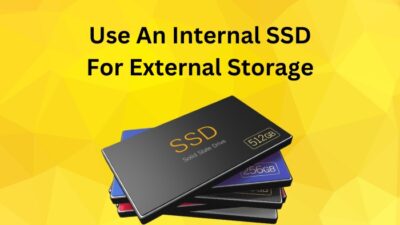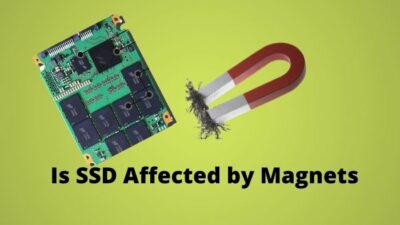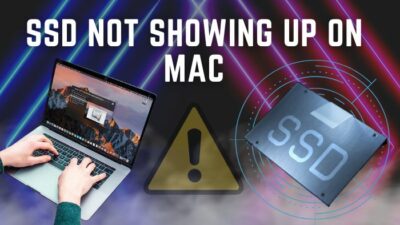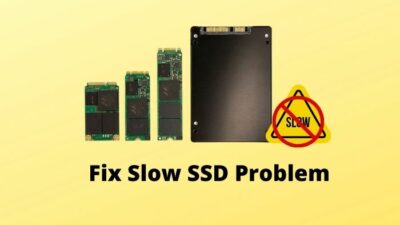The storage link through PCIe lanes has brought a revolution. And every PCIe upgrade is pushing this data transfer & read limit significantly.
Since PCIe 5.0 has been available at the consumer level, the newer PCIe storage solution is changing the hierarchy of the fastest NVMe SSDs. Each newer generation PCIe lane is getting twice as fast, and so do the SSDs.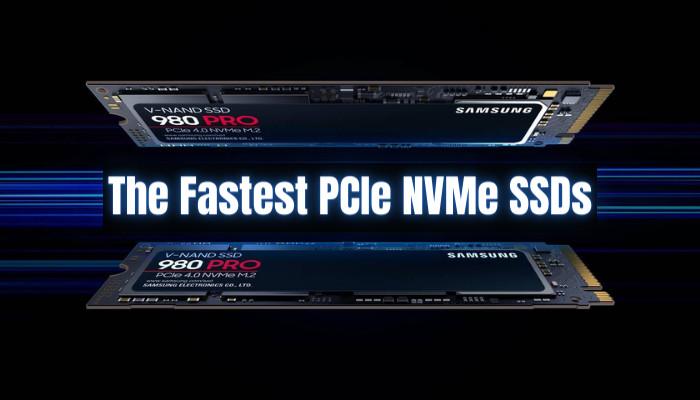
Therefore, I’ll nominate the six latest PCIe storages according to speed, real-life use, and gaming performance.
6 Fastest PCIe Storages You Can Own Right Now
| Award | PCIe Storage Model | Read & Write (Claimed) |
|---|---|---|
| Top Most Speedy | Crucial T700 | Read: 12,400MB/s Write: 11,800MB/s |
| Runner-Up | AORUS Gen5 10000 | Read: 9,500 MB/s Write: 8,500 MB/s |
| Fastest PCIe 4.0 | Samsung 990 Pro | Read: 7,450 MB/s Write: 6,900 MB/s |
| Best For Gaming | WD_BLACK SN850X | Read: 7300MB/s Write: 6300MB/s |
| Fastest PCIe 3.0 | Samsung 970 Evo Plus | Read: 3,500 MB/s Write: 3,300 MB/s |
| Fastest DRAM Less | Samsung 980 | Read: 3,500 MB/s Write: 3,000 MB/s |
The Speed of a PCIe SSD depends on many different parameters. The PCIe lane is one of the noticeable ones. Since PCIe 5.0 is the latest and fastest yet, PCIe 4.0 & 3.0 have their speed star champions.
We’ll test several PCIe storages with synthetic benchmark tools and share some real-life user experiences through this article. And the fastest choices will take place in the further sections with the best use cases like gaming, productivity, the overall transfer rate, DRAM or DRAM-less HMB, and so on.
Top PCIe 5.0 NVMe SSDs Currently Available
With each PCIe generation upgrade, the transfer speed increases twice as fast as the previous generation. PCIe 5.0 does not disagree with that either.
Although PCIe 5.0 is a relatively newer technology, some memory maker brands brought new and exceptionally fast units. More recent games with Direct storage support also use such a wide bandwidth.
However, most other games aren’t showing any visible improvement in FPS from these SSDs. But the data transfer is much faster indeed.
Crucial T700: Top Most Speedy Storage
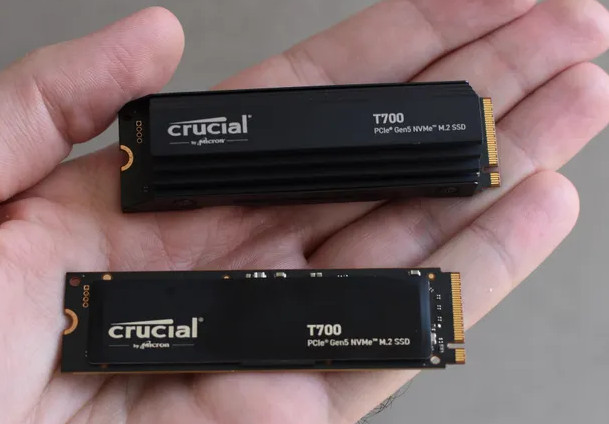
- »Highest data transfer speed.
- »Multiple Storage Choice. (1, 2, & 4TB)
- »Advanced memory block – Micron® 232-layer TLC NAND.
- »Faster gaming with Microsoft® DirectStorage.
- »The price is too high.
Why We Picked It as the Most Speedy SSD
In recent times, there has been no other NVMe available that offers a real-life read & write speed above 10,000 Mbps. T700 is one of a kind with the newest Phison E26 controller. In our test, we were surprised to see such low latency compared to other PCIe 4.0 NVMe SSDs.
Unsurprisingly, this Crucial T700 NVMe has scored 12423 Mbps read & 11870 Mbps write in the Crystal Disk benchmark as peak sequential speed. It’s slightly better than what Crucial has advertised.
Who is it For
If you are a person with no compromise and keen to keep your system THE fastest and latest, Crucial T700 is the only choice in the current situation?
Although this benchmark result depends on several facts, you’ll at least achieve more than 10000 Mbps if your rig is capable enough. So, the performance is undoubtedly the best, as this PCIe SSD is a bit pricey.
We’d recommend skipping this powerpack if you don’t own a chipset or mobo with PCIe 5.0 support.
What Could Be Improved
As we noticed, the upgrade from PCIe 3.0 to PCIe 4.0 couldn’t bring a significant thrust in gaming. But this PCIe 5.0 could be better instead of extending synthetic performance.
Verdict
The current market Speedstar T700 is the absolute choice for PCIe 5.0-supported chipset and top-tier components to harness its full potential.
AORUS Gen5 10000: Runner-Up Storage
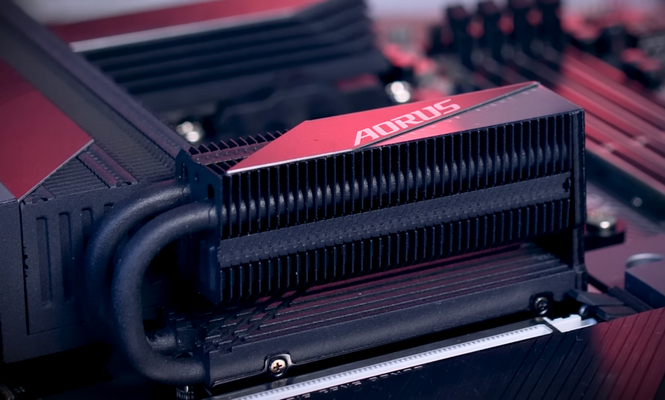
- »Aggressive Heatsink Design.
- »App support of GIGABYTE CONTROL CENTER (GCC).
- »Without-Heatsink variant’s price is affordable.
- »No wide storage choice. (1 & 2TB only)
Why We Chose It as the Best PCIe 5.0 Alternative
Even though our first priority in choosing the best PCIe storage solution is read & write speed in real-life use, the large & attractive heatsink caught our intrigue. The Aurous Gen5 10000 also has the same Phison E26 controller as T700, but the transfer speed is slightly lower.
We tried this PCIe 5.0-based NVMe on a PCIe 4.0 M.2 slot and noticed it could beat WD Black SN850X PCIe 4.0 NVMe storage with sequential 7,000 MBps maximum read, and 6,850 MBps write speed.
Plus, the nanocarbon-coated heatsink stabilizes the overall performance, solving the thermal throttling issue.
Who is it For
It’s pretty evident for hardcore gamers who need a killer speedy NVMe PCIe 5.0 storage with a very good-looking heatsink. Because power users usually spend on the extra heatsink for better storage cooling performance.
The Aorus Gen5 10000 is like beauty with the beast. If you want such a thing, this is your only choice.
What could be Improved
The attractive heatsink above is eye-catching, but unfortunately, the Aorus Logo has no RGB illumination, which could be a deal-breaking attribute so far.
Verdict
Gigabyte Aorus series products are well-known as the best performer, so it’s a pretty good choice in a gaming build with an aggressive look.
Best PCIe 4.0 NVMe Storage Choices
It’s been a long since PCIe 4.0 lanes were mainstreamed, and the choice is extensive. The brands offer NVMe SSDs in an aggressive price segment, confusing the buying decision.
We are here to rescue you from such delusion. The best PCIe 4.0 choices are included here with proper explanations.
Samsung 990 Pro: Fastest PCIe 4.0
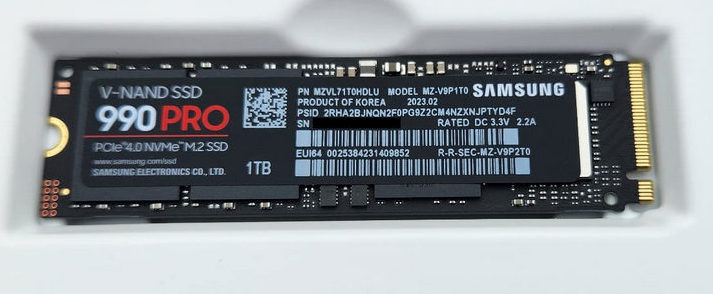
- »Better thermal performance with a nickel-coated controller.
- »Samsung Magician software support.
- »Samsung V-NAND 3-bit MLC Memory block.
- »The performance of sustained writing couldn’t meet expectations.
Why We Picked It as the Fastest PCIe 4.0 SSD
Samsung has been dominating the NVMe market since PCIe 3.0, yet, the PCIe 4.0 market is also conquered by Samsung 990 pro. The Pascal controller in 990 Pro is excellent at its job and capable of cashing & transferring data faster.
This PCIe 4.0 NVMe has a peak speed of 7153 MBps read & 6820 MBps write on our test with Crystal Disk Benchmark. And Full performance mode enabling Samsung Magician software is another reason for choosing this as the Fastest PCIe 4.0 SSD. Although the read speed isn’t the best among competitors, the write speed is outstanding.
Who is it For
The PCIe 4.0 is currently popular with B550, X570, Z490, Z590, and Z690 motherboards. The PCIe 4.0 owners can easily choose the 990 Pro SSD under 100$, an affordable price. Moreover, the extended full-performance mode has some additive potential.
Currently, this is a bang-for-buck choice for every PCIe 4.0 owner.
What could be Improved
As mentioned, sustained writing has some issues with 990 Pro, and the MLC memory block won’t perform well like TLC. The SABRENT Rocket is a good alternative for a long, hassle-free & consistent performance.
Verdict
The performance Samsung 990 Pro offers are worthy and cost-efficient, and the brand value inherits a quality assurance.
WD_BLACK SN850X: Best PCIe SSD For Gaming
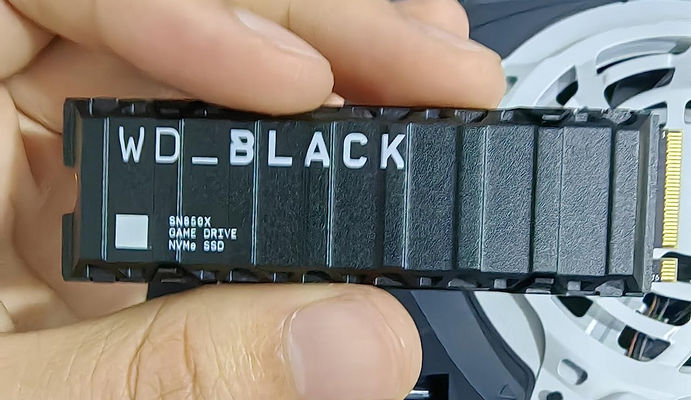
- »Better gaming performance with Game Mode 2.0 feature.
- »The DirectStorage Support for adaptive software & games.
- »With or Without heatsink choice.
- »PS5 compatibility.
- »Various storage space choices. (1, 2, 4TB)
- »Thermal throttling if you buy without a heatsink & your mobo has no heatsink either.
Why We Chose It as The Best Gaming PCIe 4.0 SSD
The transfer speed, as well as the gaming performance of this WD black SN850X, is awe-inspiring for game-centric people. Furthermore, it supports the PS5 console. Although it’s not the fastest PCIe 4.0 storage, overall performance with WD’s X factor impact is visible everywhere.
The Crystal Disk Benchmark on our test showed 1373 MBps read & 6689 MBps write speed in sequential read-write. And the WD Dashboard software support is a plus. FYI, our game testing team declared gaming with this SSD is better.
Who is it For
The PS5 owners can leap without doubts for a better gaming experience. And Windows gamers will also benefit from games with Direct storage support like ForSpoken. Plus, Game Mode 2.0 brings more joy into the gaming experience.
Long story short, professional gamers and PS5 owners are in luck to choose SN850X PCIe 4.0 SSD for the current attractive price.
What could be Improved
The hardware-based encryption could be better, whereas most other PCIe 4.0 SSDs offer 256-bit AES encryption with a bit more transfer speed.
Verdict
The Black series storage solutions are always renowned as the ultimate choice, so overall tests say “shut up & take my money” to gamers.
Fastest PCIe 3.0 Storage with or without DRAM
The PCIe 3.0 is relatively old but still worth every penny if you own a PCIe 3.0 motherboard. As these are your only choices, we chose the best PCIe SSD- one with DRAM and another with HMB here.
Samsung 970 Evo Plus: Fastest PCIe 3.0 NVMe – With DRAM
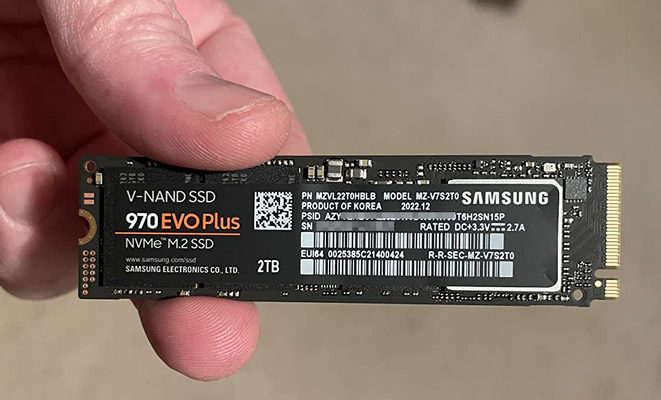
- »Intelligent Turbo Write technology.
- »Auto Garbage Collection Algorithm.
- »Best choice in budget.
- »Enhanced controller, faster than the 970 Pro series.
- »V-NAND 3-bit MLC is not as good as TLC.
Why We Picked It as the Fastest PCIe 3.0 SSD
The pro series PCIe SSDs are faster than any other SSDs, but the 970’s generation is unique. When the 970 Pro was released, the 970 Evo Plus took the market by storm because of its extended speed with Samsung’s in-house memory controller.
Still, the 970 Pro is the fastest of all PCIe 3.0 SSDs, with a 3285 MBps read & 3070 MBps write speed, in our test with Crystal Disk Benchmark. It is THE best choice under 55$ price range.
Who is it For
All the PCIe 3.0-supported chipsets, like B450, B460, A320, etc., must use this PCIe SSD, as it offers impressive speed with DRAM support. It can even beat the DRAM-less PCIe 4.0 SSD performance easily.
So, if you do not own a chipset or motherboard with PCIe 4.0 support, the Samsung 970 Evo Plus is a great storage solution.
What could be improved
The performance stability of the 970 Evo Plus isn’t top-notch. And the memory blocks are MLC, which is suitable for cheaper SSDs, but TLC 3D NAND memory blocks are better.
Verdict
The Samsung 970 Evo Plus has been rocking the PCIe 3.0 market since 2019 till now. There is barely a better option than the 970 evo plus for PCIe 3.0 owners.
Samsung 980: Fastest DRAMless- HMB Support
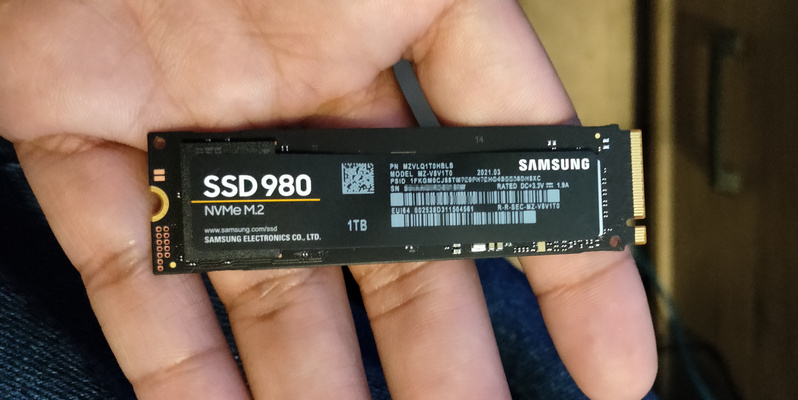
- »DRAM’s cheaper alternative 一 HMB (Host Memory Buffer).
- »Advanced security with AES 256-bit Encryption.
- »The cheapest option for budget-friendliness.
- »No larger storage variant than 1TB.
Why We Chose It the Fastest DRAMless SSD
Among the wide variety of DRAM-less PCIe SSDs, the Samsung 980 performs better because of the adoption of HMB technology. Somehow it works or acts like DRAM but not like built-in DRAM.
The Host Memory Buffer (HMB) technology in the Samsung controller uses a portion of physical memory (RAM) to store data location in memory blocks. Although it’s not as effective as an actual DRAM, it helps the SSD to perform better than other DRAM-less NVMe SSDs.
We noticed 3572 MBps read & 2887 MBps write speed by running a sequential benchmark test with Crystal Disk. This seems similar to SSD benchmark results with DRAM, but the real-life use case is slightly poorer, even with HMB.
Who is it For
If your budget is capped under $ 45-50$, and you aren’t planning for the absolute best performance, then the Samsung 980 will get your job done with decent performance. But the power users will feel the difference as there is no DRAM cache.
What could be Improved
Some issues are reported by AMD users that Samsung NVMe firmware isn’t performing well until a firmware update of the 980 pro series. But there should not be such unexpected errors from such a reliable brand.
Verdict
Price is the only thing that makes sense when buying a cheap PCIe SSD. But the HMB technology turned this SSD into a favorable position.
How We Chose the Best & Fastest PCIe SSDs
The PCIe SSDs are the primary Storage devices nowadays. The entire system runs on this, which requires a speedy environment. The latest PCIe storage solutions focus on that.
Therefore, we tested these SSDs with the fastest boot time race, synthetic benchmark test, data transfer speed test, and considering other specs with hardware capabilities. Then we test the thermal throttling by installing & removing the heatsink to check if the SSDs overheat.
After those tests and inspections with a booted SSD on a 5700G CPU-based rig, we decide the best options. Then non-booted drive to check if the result differs.
We even tried those SSDs directly through a PCIe x16 slot without using the SSD in M.2 slot to observe changes in performance.
The final result is presented simply to make a novice understand what they should purchase. On top of that, we add key specifications that matter the most. And some advanced features and the design are judged by real-life use cases.
FAQs
Is NVMe the same as PCIe?
The NVMe means Non-Volatile Memory Express, a protocol, and PCIe, on the other hand, is an interface.
Which SSD type is best?
The PCIex4 NVMe SSDs are the fastest storage because the SATA SSDs are capped at 6GBps.
Is Ram faster than a PCIe SSD?
The Physical Memory-RAM is faster than any NVMe SSDs in the market & way faster than HDD.
What are the three types of SSD?
The SSD types of SSDs are SATA 2.5 inch, M.2 SATA, and PCIe NVMe SSD.
Does an NVMe need a heatsink?
The NVMe drives do not necessarily require a heatsink, but large operations or workloads with lots of data might produce heat in NVMe memory blocks.

